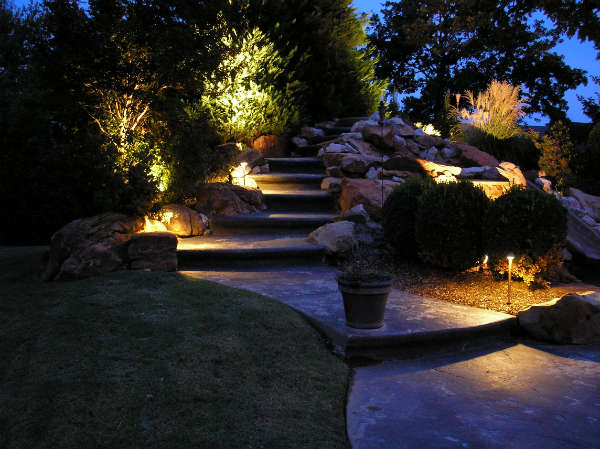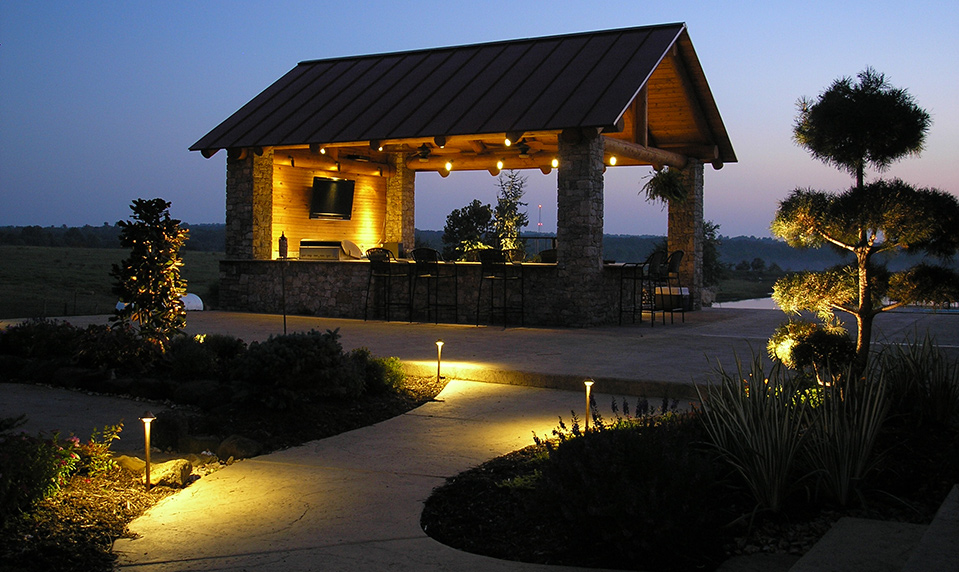
Outdoor lighting enhances the beauty and safety of homes and their surrounding environments. Most systems are professionally designed and installed, saving homeowners valuable time and concerns about their aesthetics, durability, and security benefits.
No licensing, certification, or permitting is usually required for outdoor lighting installations. This requires diligence when choosing an outdoor lighting contractor to get the expected quality. Let’s explore some of the differences that separate experienced professionals and where those quality distinctions sometimes hide.
#1. Design and Aesthetic Appeal
Professional landscape lighting designers have the expertise to enhance your home’s exterior with the right balance of light and shadow. They use principles of layering, contrast, and focal points to create a visually stunning nighttime environment. A professional ensures that pathways, trees, architectural features, and outdoor living spaces are lit in a functional and inviting way.
Without experience, lighting installations often produce undesirable ‘hot spots’ and unbalanced illumination that diminishes curb appeal.
#2. Enhanced Safety and Security
A well-lit property deters potential intruders by eliminating dark areas where they could hide. Professionals understand strategic placement to maximize security without excessive brightness.
Additionally, proper lighting along walkways, steps, and driveways reduces the risk of accidents and falls, ensuring the safety of family members and guests. A professional will ensure the correct fixture placement and brightness levels to enhance safety without creating light pollution.
#3. Proper Fixture Placement and Wiring
Landscape lighting is not just about placing fixtures around your yard—it involves proper wiring, voltage distribution, and waterproofing. Professionals ensure that wires are buried safely, connections are secure, and fixtures are placed to provide the best lighting effects without being an eyesore.
Poorly installed wiring can lead to voltage drops, causing some lights to be dimmer than others, or worse, creating fire and electrocution hazards.
#4. High-Quality, Long-Lasting Materials
A professional installer can access commercial-grade fixtures and more durable components than those found at big-box stores. These materials withstand harsh weather, resist corrosion, and provide consistent illumination over time.
Less expensive solutions use cheaper plastic fixtures that fade, crack, or stop working after just a few seasons. Investing in a professional installation ensures longevity and reduces the need for frequent replacements.
#5. Energy Efficiency and Smart Technology
A professional can incorporate energy-efficient solutions such as LED lighting, solar-powered options, and smart lighting systems that integrate with home automation. They can install timers, motion sensors, and remote-controlled systems to reduce energy consumption and increase convenience.
#6. Customizable and Scalable Solutions

A professional lighting designer can create a system that grows with your needs. Whether you plan to add a patio, pool, or landscaping features, they can design a flexible system that accommodates future expansions like the outdoor living space above.
#7. Correct Use of Lighting Techniques
Professionals use lighting techniques— uplighting, downlighting, moonlighting, and silhouette lighting—to achieve the desired ambiance. Inexperienced installers sometimes locate lights without considering key design factors, leading to excessive glare, dark spots, or an unnatural appearance.
A professional understands how to use different techniques to highlight trees, water features, and architectural elements for the most dramatic and effective results. He or she also knows that some foliage reflects and enhances lighting effects. In contrast, most evergreens absorb light that disappears into the tree or shrub.
#8. Maintenance Free Installations
A professionally installed landscape lighting system requires less maintenance. Experts use durable fixtures, correct wiring, and weatherproof connections to minimize breakdowns.
Many professionals also offer maintenance plans to clean lenses, adjust fixtures, and replace bulbs as needed. Just before our unpredictable Oklahoma winters is an ideal time to perform this service.
#9. Increased Property Value and Curb Appeal
Well-designed outdoor lighting enhances your home’s visual appeal, making it more attractive to potential buyers. Real estate experts agree that a beautifully illuminated home stands out in the market and can even increase property value. On the other hand, poorly executed lighting can make a home look cluttered or uninviting, deterring buyers rather than attracting them.
#10. Code Compliance and Warranty Protection
In many circumstances, low-voltage outdoor lighting can be installed without permits or licensing. Nevertheless, you can expect professionals to adhere to local codes and safety regulations as necessary. For example, installing a subpanel on a home’s existing main electrical panel to expand its capacity for your outdoor lighting system will require a licensed electrician.
Additionally, many professional installations come with warranties, providing homeowners peace of mind. If a lesser system fails, homeowners are left troubleshooting and replacing components at their own expense. Yet, the most significant cost is the time involved in pinpointing and fixing the problem.
Proactive Landscaping: Helping Oklahoma Homeowners Enjoy Outdoor Living
Our top priority is creating living spaces that are right for you. We pride ourselves on working with you from concept to construction to make the right landscape for your needs. Contact us today for a free consultation to explore your next landscaping project.

